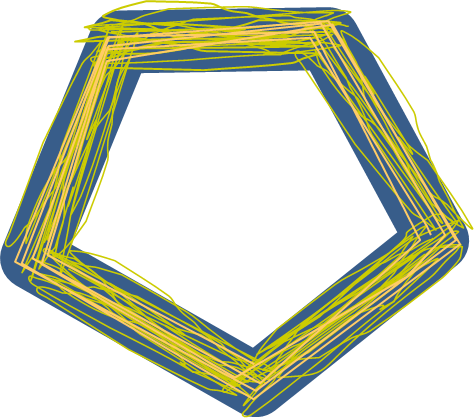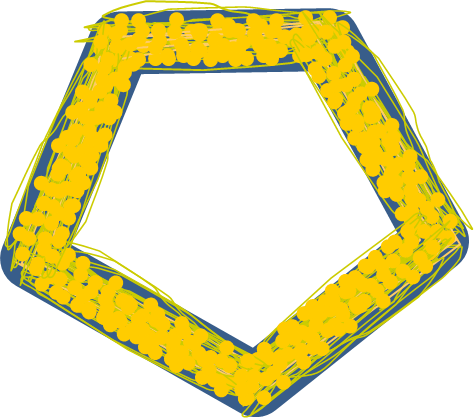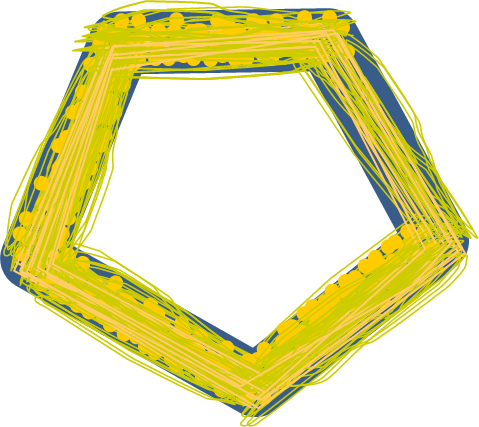3D structures from patterned collector
Patterned collector has been shown to be capable of constructing electrospun two dimensional patterned meshes. By varying the shape and topography of the patterned collector, three-dimensional structures may also be constructed when combined with other techniques. Unique patterned three-dimensional structures may be constructed and this may be very useful for some applications where more ordered fiber organizations are preferred.
With a patterned collector, three-dimensional (3D) patterned fibrous scaffold has been constructed using a combination of electrospinning and electrospraying. Wittmer et al (2014) was able to build a layered electrospun structure up to 100 µm height with honeycomb patterns that followed the patterned collector by alternating electrospinning and electrospraying. Electrospinning and electrospraying were initiated using a positive high voltage and the collector was given a negative high voltage. Both the fibers and the particles preferentially deposits on the collector struts although there were some stray fibers that bridges the cavity. Alternative setup such as electrospinning alone or alternate electrospinning from two separate nozzles were unable to build up a tall fiber column or form patterned structure respectively. A possible reason for such organization when electrospinning and electrospraying are used is that electrospinning first creates a mesh of organized fibers. Electrospraying fills some of the gap between the fibers that form the wall thereby creating a path for the electrical charges to escape to the negatively charged collector from the otherwise less conducting porous fibrous structure. This recreates a more solid surface for the incoming fibers to deposit. However, the buildup of the non-conducting fibers eventually leads to fiber disorder and loss of the pattern [Wittmer et al 2014].
Illustration on the stages to the formation of 3D patterned fibrous scaffold (Adapted from Wittmer et al 2014)

|
Electrospun fibers deposited on the patterned collector. Gaps between fibers hinder charge migration to the collector which causes a gradual buildup of residual charges. |

|
Electrospraying of particles preferentially fills in the gap between the fibers. This creates shorter routes for the charges to escape to the collector. With portion of the gaps filled, a more solid surface is presented for the next layer of electrospun fibers. |

|
Electrospun fibers preferentially deposit on the particles-fibers surface. |
It is important to note that the patterned collector used for constructing three-dimensional structure using this method comprises of walls raised to the same height instead of woven wire mesh with undulating topography which is commonly used for fabricating two-dimensional patterned membranes. Walls of the same height create a more orderly electric field distribution to the elevated surface which encourages fiber deposition on the top surface.s pointing towards the spinneret creates a collection setup consists mainly of empty space. Nanofibers will preferentially rest on the tip of the needles but its weight and the collision of the incoming fibers cause the resting fiber to collapse into the space between the needles. As a result, a loosely packed nanofibrous structure is formed [Phipps et al 2011]. In a different setup, an array of needles in a radial configuration and a space behind it (as shown in the diagram below) was used to fabricate 3-dimensional nanofibers [Blakeney et al 2011]. The presence of the needle array encourages the electrospinning jet to spin towards an almost empty space to be gathered. Fluffy and uncompressed clump of nanofibers has been constructed using this method.

|
| A flat elevated wall grid is essential for the collection of 3D patterned fibers as opposed to the conventional patterned undulating grids collector. |
Electrospinning has been used to construct three-dimensional fibrous structures by depositing fibers on collectors with three-dimensional profiles. Similarly, if the collector used is made out of patterned grids, a patterned three-dimensional fibrous structure can be constructed. Using melt electrospinning, Brown et al (2014) deposits fibers on a domed shaped patterned collector with the fibers preferentially depositing on the struts of the porous grid dome. The completed product has a domed shape macrostructure with square porous patterns with fibers forming the walls.
Last updated: -
 ElectrospinTech
ElectrospinTech